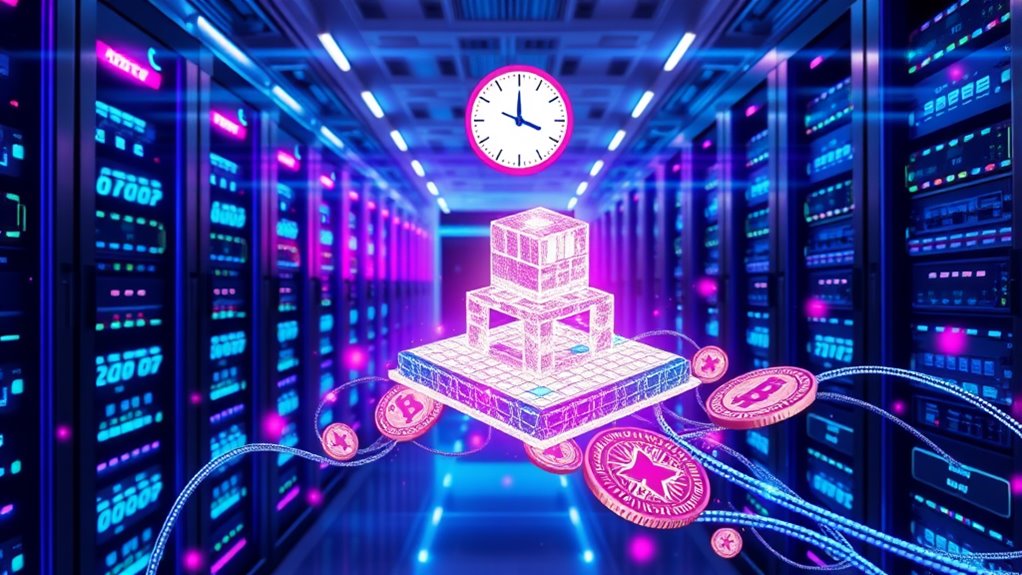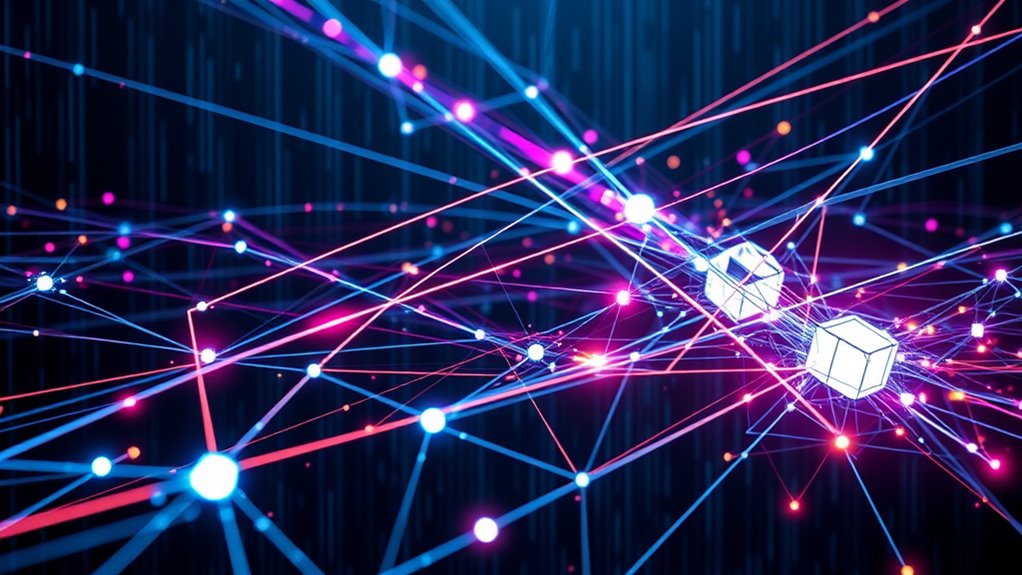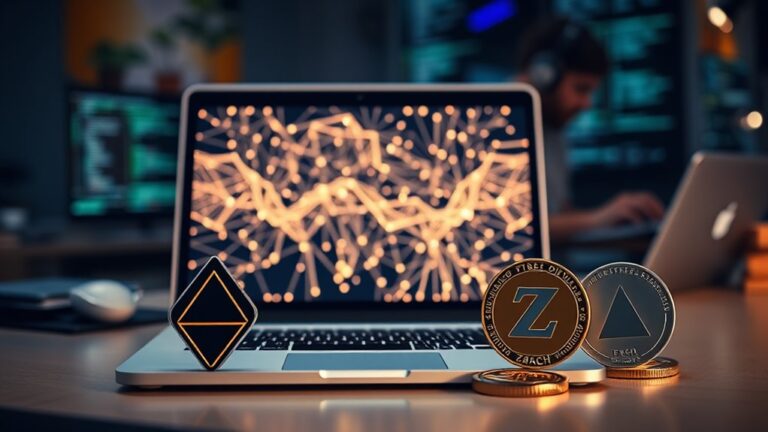
Layer 2 Altcoins: Unlocking Faster Blockchain Transactions
Layer 2 altcoins improve blockchain efficiency by using off-chain processing to enhance speed and scalability. They increase transaction throughput and lower fees, easing network congestion on primary blockchains. This innovation is crucial for applications like gaming and decentralized exchanges, where high transaction volumes prevail. Key technologies, such as Optimistic and Zero-Knowledge Rollups, underlie these improvements. As developments continue, these technologies promise to shape the future of blockchain transactions, offering much more to discover.
Key Takeaways
- Layer 2 altcoins enable faster transactions by processing them off-chain, reducing blockchain congestion.
- Technologies like Optimistic Rollups and Lightning Network enhance transaction speed and efficiency.
- Lower transaction fees make microtransactions feasible, broadening blockchain usability.
- These solutions inherit security from foundational blockchains, ensuring stable processing.
- Layer 2 altcoins are crucial for high-volume applications like gaming and decentralized exchanges.
Definition and Importance of Layer 2 Altcoins

Layer 2 altcoins, born from the need to improve blockchain technology, play an essential role in enhancing the efficiency of cryptocurrency networks.
Layer 2 altcoins significantly boost cryptocurrency network performance by enhancing blockchain technology efficiency.
These technologies, built atop existing blockchains, aim to boost scalability and transaction speed without sacrificing security. They work by enabling transactions to be processed off-chain, thereby easing congestion on main blockchains and improving overall transaction efficiency.
Layer 2 solutions inherit the robust security of their foundational blockchain, maintaining stable and secure processing. Examples include rollups, state channels, and sidechains, each employing unique strategies to increase throughput.
They're popularly used in high transaction volume scenarios like gaming and decentralized exchanges. By addressing critical issues, these altcoins are instrumental in advancing blockchain technology. Blockchain functions as a decentralized, immutable ledger system, allowing users to trust the accuracy and security of transactions without depending on a central authority.
Key Advantages of Implementing Layer 2 Solutions

- Increase Transaction Throughput: They enhance blockchain networks' ability to process more transactions, accommodating high-volume applications effortlessly.
- Reduce Network Congestion: By processing transactions off-chain, these solutions prevent congestion on Layer 1 blockchains, like Ethereum and Bitcoin.
- Lower Transaction Fees: Off-chain processing brings costs down, making transactions more affordable for all users and enabling cost-efficient microtransactions.
- Improve Speed and Performance: Near-instant transaction finality and faster processing times benefit applications like gaming and high-frequency trading, boosting real-time interactions and user engagement.
These aspects collectively benefit the blockchain ecosystem, enhancing user experience and promoting broader adoption.
Prominent Technologies Enabling Layer 2 Enhancements

Numerous technologies play a significant role in facilitating Layer 2 enhancements, each contributing to the scalability and efficiency of blockchain systems. Off-chain processing, such as state channels and sidechains, reduces Layer 1 burdens. Cryptographic proofs and innovative rollups, including Optimistic Rollups and ZK-Rollups, guarantee transaction validity. These methods increase throughput while preserving decentralization. Prominent implementations like Ethereum's Optimistic Rollups and Bitcoin's Lightning Network exemplify successful Layer 2 applications. Furthermore, Layer 1 platforms like Solana and Avalanche are recognized for their technological advantages, making them increasingly attractive alternatives in the evolving crypto landscape. The table below summarizes key Layer 2 features:
| Feature | Description |
|---|---|
| Off-Chain Processing | Reduces load on Layer 1 by handling transactions offline |
| Cryptographic Proofs | Guarantees secure, valid transactions |
| Scalability Enhancement | Increases transaction throughput |
| Decentralization Preservation | Maintains security linked to Layer 1 |
| Complexity Reduction | Eases computational demands on Layer 1 |
These technologies form the backbone of efficient Layer 2 solutions.
Real-World Use Cases for Layer 2 Applications

As the digital economy continues to evolve, the implementation of Layer 2 solutions increasingly shows promise across various sectors, providing tangible benefits in real-world settings.
In finance, these solutions enable vital advancements:
- High-Frequency Trading: Platforms like Uniswap benefit from faster, cheaper transactions, promoting efficient high-frequency trading.
- Microtransactions: Reduced fees make small transaction amounts viable in everyday scenarios, broadening blockchain use.
- Asset Settlements: With quicker transaction times, financial entities enjoy improved liquidity in rapid asset movements.
- Cross-Chain Transfers: Enhanced interoperability through Layer 2 solutions allows seamless asset transfers between different blockchains.
In gaming, Layer 2 offers real-time transactions and low latency, improving user engagement.
Supply chain management gains from enhanced transparency and efficient logistics.
For digital identity management, Layer 2 guarantees secure data storage and improved user control.
Transformative Impact on the Blockchain Ecosystem

How does the implementation of Layer 2 solutions transform the blockchain ecosystem?
Layer 2 solutions dramatically enhance scalability and performance, allowing blockchains to process transactions at a speed comparable to traditional systems such as VISA. By shifting transactions off-chain, these solutions effectively reduce congestion on primary blockchains, leading to smoother network operations and lower transaction costs.
Layer 2 solutions boost blockchain speed and efficiency, reducing costs and network congestion by handling transactions off-chain.
This accessibility encourages widespread adoption and supports the growth of decentralized applications (dApps) and decentralized finance (DeFi) platforms, opening up new business opportunities. These DeFi platforms create an ecosystem where peer-to-peer lending and investing through smart contracts are possible, highlighting the democratization and increased accessibility of financial services.
In terms of security, Layer 2 maintains the decentralized nature of the blockchain while preserving the underlying security of Layer 1.
Technologies such as zk-Rollups provide enhanced security and privacy, while Optimistic Rollups offer mechanisms to resolve disputes, ensuring reliable transaction integrity.
Future Developments and Potential Challenges

In the domain of Layer 2 altcoins, Ethereum 2.0 advancements present a promising future, as upgrades like Danksharding are set to bolster efficiency and reduce transaction costs. While projects such as zkSync and Starknet spearhead innovations in zero-knowledge technology, they contend with technical challenges, including the complexity of implementation and potential security risks. Furthermore, as Layer 2 solutions evolve, they have the potential to drive mainstream acceptance through deeper integration with DeFi platforms and real-world applications. Additionally, the ongoing evolution of Layer 2 solutions raises new obstacles, including regulatory uncertainties and the need to maintain robust user experience, as these technologies become increasingly integrated with DeFi, NFTs, and cross-chain applications.
Ethereum 2.0 Advancements
Ethereum 2.0 represents a significant transformation in the landscape of blockchain technology, marked by a shift from Proof-of-Work (PoW) to Proof-of-Stake (PoS) consensus mechanisms. This advancement seeks to enhance Ethereum's scalability, energy efficiency, and security.
A phased rollout is underway, beginning with Phase 0 and the Beacon Chain. Notable elements of Ethereum 2.0 include:
- Scalability through Sharding: Shard chains enable parallel transaction processing, boosting network throughput and potentially leading to lower gas fees.
- Improved Security: PoS adds mechanisms like slashing to penalize dishonest validators, bolstering network security.
- Faster Transactions: PoS facilitates quicker block creation, reducing transaction times and improving user experience.
- Developer and User Benefits: Enhanced tools and increased decentralization expand applications for decentralized apps (dApps).
Additionally, Ethereum's transition from proof-of-work to proof-of-stake, known as "The Merge," is key to realizing these benefits, as it aligns with the platform's goals for greater programmability and efficiency.
Innovations and Obstacles
As blockchain technology relentlessly evolves, innovations in Layer 2 scalability present both exciting opportunities and intricate challenges.
Rollup technologies, such as Optimistic and Zero-Knowledge Rollups, efficiently consolidate transactions, while Starknet's use of STARK proofs and zkSync Era's advanced zero-knowledge technology greatly enhance performance.
Despite these advances, complexities and technical demands pose integration hurdles for new users or developers. Ensuring robust security necessitates continuous upgrades, with interoperability issues presenting additional obstacles.
The delicate balance between scalability and safety remains a focal point. Future strategies include refining sidechain architecture and employing cryptographic methods to boost scalability and user experience. Additionally, regulatory clarity could significantly impact the Layer 2 solutions by providing a more structured environment for developers and investors alike, thus enhancing the adoption of these technologies.
Ultimately, effective adoption of Layer 2 solutions hinges on addressing these challenges to foster accessible, rapid blockchain transactions.
Frequently Asked Questions
How Do Layer 2 Solutions Impact Transaction Confirmation Times?
Layer 2 solutions markedly decrease transaction confirmation times by processing them off-chain, achieving near-instantaneous results. This speed is critical for real-time applications, enhancing overall network efficiency and user experience by minimizing latency and congestion on the blockchain.
Can Layer 2 Solutions Reduce Blockchain Environmental Impact?
Layer 2 solutions, akin to a turbo boost, minimize blockchain's environmental impact by offloading processes from the main chain. They enhance transaction efficiency, reduce computational load, and decrease energy consumption, promoting eco-friendly blockchain innovation.
What Role Do Validators Play in Layer 2 Networks?
Validators in Layer 2 networks enhance transaction integrity by ensuring compliance with consensus protocols. Their role includes verifying transaction batches through cryptographic proofs before settlement on the main blockchain, maintaining security, and preventing fraudulent activities in decentralized networks.
How Do Layer 2 Altcoins Differ From Layer 1 Altcoins?
Layer 2 altcoins stand out from Layer 1 altcoins by providing enhanced scalability and transaction speed. While Layer 1 focuses on decentralized security and foundational functions, Layer 2 optimizes for efficiency, offering improved transaction costs and times.
Are Layer 2 Solutions Compatible With All Cryptocurrencies?
Layer 2 solutions, akin to bridges spanning diverse lands, connect selectively, forging paths over specific blockchains like Ethereum or Bitcoin. Compatibility depends on the supportive architecture of the base coin, not universally inclusive of all cryptocurrencies.
Conclusion
Layer 2 altcoins are swiftly becoming the backbone of faster blockchain transactions, like a well-oiled machine enhancing the overall system. By alleviating congestion and increasing efficiency, these technologies open up new possibilities for real-world applications and set the stage for a transformative impact on the blockchain ecosystem. However, as these solutions continue to evolve, addressing scalability and security challenges remains essential to achieving their full potential and ensuring a seamless integration into the digital future.












